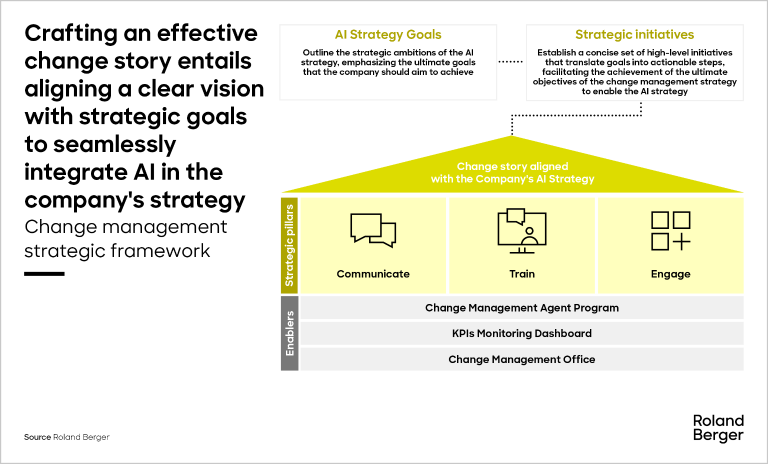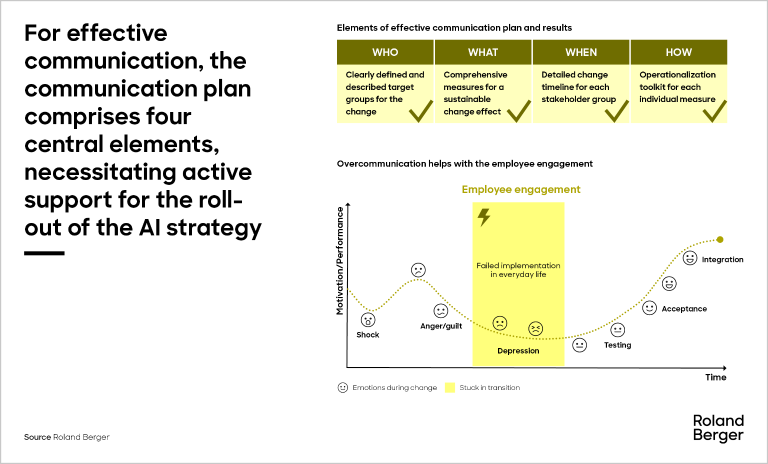Explore the transformative power of Generative AI in business. Uncover how AI, like ChatGPT and Google Gemini, is reshaping industries, automating tasks, and creating new opportunities for innovation. Learn how leaders can navigate this revolution, balancing risks with the potential for unprecedented competitive advantage. Dive into the future of AI with us and redefine your business strategy.


Change management and AI
How can businesses adopt a people-centric approach to maximize the benefits of new disruptive AI-based technologies?
In today's rapidly evolving business landscape, artificial intelligence (AI) has become a game-changer for organizations looking to stay ahead of the competition. However, implementing AI technologies can be a daunting task, especially for those who are new to this field. In this report, we will explore a people-centric approach to maximizing the benefits of AI.
This report provides a detailed analysis of the key steps involved in maximizing AI's benefits, as well as practical advice and case studies from leading organizations.

The report highlights the importance of adopting a people-centric approach to AI, which involves five key steps. It examines each of these steps and grasps how they can empower organizations to fully unleash the potential of AI.
Step 1: Define a clear vision
The first step in maximizing the benefits of AI is to define a clear vision. This involves identifying the specific business problems that AI can solve and setting clear goals for AI implementation. By defining a clear vision, organizations can ensure that their AI initiatives are aligned with their overall business strategy and objectives.
Step 2: Integrate AI and change strategy
The second step is to integrate AI and change strategy. This involves understanding the impact of AI on the organization's people, processes, and technology, and developing a change strategy that addresses these impacts. By integrating AI and change strategy, organizations can ensure that their AI initiatives are implemented in a way that is both effective and sustainable.
Step 3: Communicate effectively
The third step is to communicate effectively. This involves communicating the benefits of AI to all stakeholders, including employees, customers, and partners. By communicating effectively, organizations can ensure that their AI initiatives are understood and supported by all stakeholders.
Step 4: Empower and encourage experimentation
The fourth step is to empower and encourage experimentation. This involves creating a culture of experimentation and learning, where employees are encouraged to test and learn with AI technologies. By empowering and encouraging experimentation, organizations can ensure that their AI initiatives are iterative and continuously improving.
Step 5: Establish metrics and monitoring
The fifth and final step is to establish metrics and monitoring. This involves defining clear metrics for AI success and monitoring the performance of AI initiatives over time. By establishing metrics and monitoring, organizations can ensure that their AI initiatives are delivering the expected benefits and that any issues are identified and addressed in a timely manner.
In conclusion, adopting a people-centric approach to AI is essential for maximizing the benefits of this technology. By following the five key steps outlined in the report, organizations can ensure that their AI initiatives are aligned with their overall business strategy, supported by all stakeholders, and delivering the expected benefits.
Register now to access the full study and uncover the potential of a people-centric approach to optimize AI benefits in business. Furthermore, you get regular news and updates directly in your inbox.









